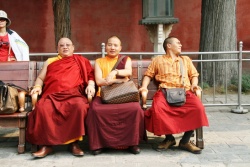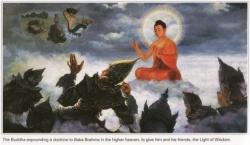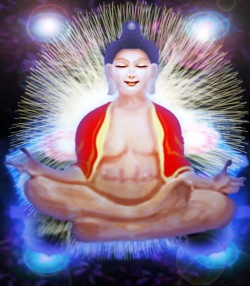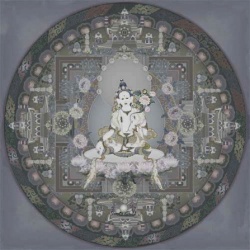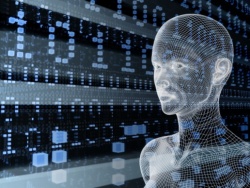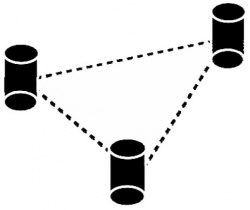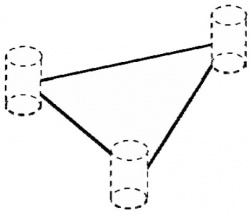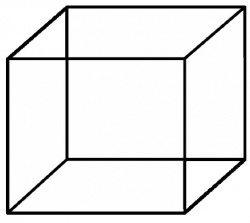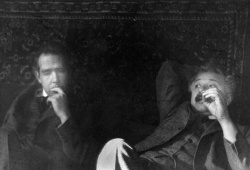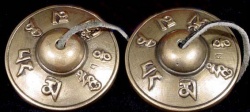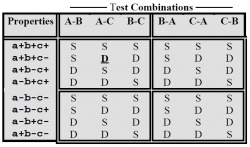The Physics of Peace: Quantum Nonlocality and Emptiness
Introduction
It is difficult to think of physics and peace at the same time. We usually think of physics as a way to amplify our violence through the production of weapons. However, there is an even more important role for physics, since it contributes mightily to our worldview, our comprehensive interpretation of the universe, ourselves, and how the two relate.
Unfortunately, our modern worldview is still far too influenced by classical physics, the view of Sir Isaac Newton and his followers. Newton envisioned the universe as being built from independently or inherently existent point particles, entities existing in their own right that secondarily come together to build more complex structures from galaxies to people. Figure 1 illustrates the classical view of entities, whether particles or people. There the entities are substantial things with the solidity of iron posts. Relations to other objects (other posts) are through dashed lines, since they are less real and substantial than the posts they connect. If classical particles could talk they would say something like, “My independent reality is primary. My relationships to other objects are secondary.”
Given its fundamental importance, the quantum mechanical view of entities is much less influential in shaping our modern worldview than it should be. In the last two decades, we have come to understand that the relationships between quantum entities are often more important, more real, than the isolated existence of the entities. Many philosophers of science consider this view, which comes from studies of quantum nonlocality, to be the most significant finding since the birth of science. In this chapter, I explain exactly what quantum nonlocality is and discuss its intimate connection to Middle Way emptiness. Through this connection, the implications of quantum nonlocality and its connection to peace become much deeper and richer.
Figure 2 illustrates the quantum mechanical view. Now the objects are diagrammed with dashed lines with solid connecting lines. This illustrates the idea that the relationships are more fundamental, more real, than any isolated objects. Actually, an object’s existence depends upon its relationship to other objects. If the quantum particles could speak they would say, “I exist in a well-defined way because of my relationship to other particles. I have no independent existence.” Such a view, which has taken much hard labor to substantiate, has not been assimilated into collective culture. It obviously has enormous implications for both personal and world peace. Physicists rarely discuss how physics shapes our worldview and influences our culture. A notable exception is the late David Bohm, internationally known for his im- portant work at the foundations of quantum mechanics. Bohm writes:
- It is proposed that the widespread and pervasive distinctions between people (race, nation, family, profession, etc., etc.), which are now preventing mankind from working together for the common good, and indeed, even for survival, have one of the
key factors of their origin in a kind of thought that treats things as inherently divided, disconnected, and “broken up” into yet smaller constituent parts. Each part is considered to be essentially independent and self-existent.[1]
Here I will show in detail how the quantum view differs from the belief of classical physics that “Each part is considered to be essentially independent and self-existent.” As this chapter will show in detail, we instead have a mysterious level of interconnectedness that is more profoundly related than we can conceive using any models from classical physics. It is a standard tenet within the Middle Way to say that emptiness itself is empty, without independent essence. I have not seen it said anywhere, but this must imply that the Middle Way’s relationship to other traditions defines it at the deepest level. In other words, emptiness implies that the Middle Way is defined by how it relates to other worldviews. Thus, comparative philosophy is built into the foundation of the Middle Way. In our day, so dominated by science, the Middle Way should therefore be examined in relation to modern science. Therefore, along with my personal needs to weave my inner and outer worlds into a harmonious fabric, a comparative study of the Middle Way with physics is an expression of its deepest reality. The most penetrating understanding of quantum nonlocality comes from the celebrated experimental violation of Bell’s Inequalities. Although much debate surrounds the proper interpretation of quantum mechanics, we can avoid this controversy by focusing on these Inequalities, which have extensive experimental and theoretical support.[2]As I will show, this analysis is independent of the present formulation of quantum mechanics. Therefore, any future replacement for quantum mechanics must embody nonlocality. Happily, we can show all this without requiring any technical background in physics or mathematics. Only a little reasoning and counting are necessary.
There is no attempt here to “prove” the doctrine of emptiness by showing its expression at the deepest level of modern physics. That would imply that physics is the more profound view and that we are using it to deduce the lesser reality, the Middle Way. Instead, I like to think of it is a conversation between two very different traditions, which are most fundamentally defined by their dialogue, by their mutually dependency.For me the dialogue begins nearly forty years ago when I was a graduate student at Cornell University. Then I looked up Einstein’s major challenge to the conceptual foundations of quantum mechanics in Einstein, Podolsky, and Rosen[3] (EPR). After all these years, I still vividly recall the dark green bindings of the Physical Review, where I was in the library, and most importantly, how the edges of the pages were so blackened by the countless fingers that have turned them. I had never seen a physics journal with such obvious marks of wear. Why did so many find EPR so compelling? Answering this question, we can begin to understand how the most fundamental insight into the nature of physical reality since Galileo connects to peace, both personal and global.
The challenge of EPR
Although Einstein’s work laid many of the foundation stones for quantum mechanics, he was never happy with the theory. From the late 1920’s up to 1935 when EPR was published, he engaged in a number of debates with Niels Bohr and others on the conceptual foundations of quantum mechanics.[4] Many physicists consider these debates to be the most thrilling and important discussions in science, on a par with the debate that raged around Galileo over the structure of the solar system. To appreciate this clash of titans, we first review the idea of complementarity, the very heart of quantum mechanics.
For a visual analog of complementarity, let your eyes relax and stare at Figure 3. You will see that there are two competing views of the square. At first, one surface appears closest to you. After looking for a moment, a different surface will appear closest to you. Upon further looking, those two views alternate, but never appear simultaneously. Here is a simple example of complementarity. The two views are equally real and important, but they are mutually exclusive.There are three important points about complementarity. First, complementary properties (such as waves and particles) require mutually exclusive experimental conditions for their study. To study the wave nature of a quantum system requires an arrangement of the laboratory apparatus that rules out a simultaneous study of its particle properties. These mutually exclusive experimental conditions prevent any conflict or inconsistency between the disparate properties. Second, both poles of a complementary pair are equally real and important in characterizing a quantum system. This eliminates any reductive strategy for understanding complementary properties. For example, you cannot say that a particle is merely a tightly localized wave. Third, a unitary reality encompasses all complementary properties in the form of possibilities for manifestation—discussed in more detail below. This unitary reality has an abstract mathematical expression in the wave function and the equations governing its evolution. The unitary reality is not on the level of the complementary properties that it unifies nor does it obliterate their differences. Although there are innumerable pairs of complementary properties in quantum mechanics, I focus on the well-known complementarity between waves and particles. In any quantum mechanical system, we can choose to study its wave nature or its particle nature; but since they require mutually exclusive experimental arrangements for their study, we can never simultaneously display both wave and particle properties. I call the “realist temptation” the view that although we cannot study the wave nature of an electron when we are examining its particle nature, the wave nature still exists in a welldefined way. In other words, we want to believe that the electron has intrinsic properties that are independent of the experimental situation. Conversely, when we study the particle nature then the wave nature still independently exists, but is just not observable. In Buddhist language, it has inherent or independent existence. As we will see, this is not the case and we are in fact projecting this independent existence into nature at the deepest levels. We are providing the false “makeup” as Lama Yeshe told us toward the end of the previous chapter. The realist temptation is a natural expectation based on everyday experience of conventional reality. However, as we will see, our experience with conventional reality, the world of stones, posts, and flowers, often leads us astray when considering the fundamental structure of nature. Instead, quantum mechanics tells us, “Do not succumb to the realist temptation; revealing one member of a complementary pair means that the other does not exist in a well-defined way.” It is not just that the members of a complementary pair require mutually exclusive experimental conditions; the unmanifest one does not exist in any reasonable sense of the word. It certainly does not inherently exist. Einstein found this a troubling aspect of quantum mechanics and in EPR sought to show that nature was not truly this way and therefore the quantum mechanical description was incomplete. To get to the essence of EPR’s scheme to show the incompleteness of quantum mechanics, we need to understand the notion of correlation. Physicists often speak about making measurements on widely separated correlated particles, those sharing similar properties. Here is a macroscopic example. Consider my pair of gloves. Let’s say a friend visits my home, mistakenly picks up one of my gloves, and carries it back to his home. Once I realized what has happened, all I need to do is see whether I have the left or right-handed glove to know which glove my friend has. If, for example, I have the left-handed glove then my friend clearly has the right-handed glove. We know this because the gloves are correlated pairs: one right and one left-handed. Of course, this correlation is independent of the distance between the gloves. There are several big differences between what EPR discussed and my gloves. First, each of the correlated particles in EPR has a complementary nature, in that each member of the pair can exhibit both wave and particle properties. (That would be something like each glove of the pair being able to exhibit right or left-handedness, depending upon exactly how we observed it. Although that might sometimes be convenient, it is hardly the nature of gloves!) Second, as we will see, the kind of correlations found between particles in EPR-type experiments seem to involve some mysterious, faster-than-light, action at a distance. However, we need to understand EPR before we can get to that mystery. Third, the correlations are statistical, as most quantum phenomena are. They are not perfect correlations, but hold a certain well-defined percentage of the time.
EPR state an important definition:
- “If without in any way disturbing a system we can predict with certainty the value of a physical quantity, then there exists an element of physical reality corresponding to this physical quantity.” (This definition might seem harmless enough, but it actually asserts the independent existence of the physical quantity that we can predict with certainty without disturbing the system. So we are right in the thick of a fundamental debate!)
EPR then consider a pair of correlated particles, one moving off to the left, and the other to the right. Consider the case when we measure the position of the particle on the left; then, since the particles are correlated, we can predict with certainty the position of the particle on the right without disturbing that particle in any way.
The typical way of ensuring that a measurement on the left does not affect the particle on the right is to separate the particles such that no information can travel between them during the time between any measurements on them. (Keep in mind that according to the principle of locality no information or energy can travel faster than the speed of light.) For example, let’s say that the particles are one light minute apart (the distance between the Sun and Earth is eight light minutes) and we make measurements on the left and right particles that are only seconds apart. Here we are ensuring no disturbance of one particle measurement on the other by the principle of locality—no information transfer faster than the speed of light. Since the idea of locality is so important, another example is in order. Imagine that we have pairs of unscrupulous twins taking exams. Being such clever swindlers, we want to be sure that they cannot cheat, that they can have no influence on each other. The only way we can truly guarantee no cheating requires us to separate them widely and carefully time the exams. For example, imagine that the exam takes one minute to complete and we put one twin on Mars and one on Earth. Each twin takes the exam at exactly the same time. Since they are about twenty light minutes apart, their exams are taken at the same time, and the exams take one minute, then there is no way that one twin can communicate with the other for the purposes of cheating.
Return to EPR’s experiment when we measure the position of the particle on the left. By appropriate separations and measurement timings, we can be sure that there is no disturbance between the particles. Then, because of the correlation between the particles, the position of the right particle is, according to EPR’s definition, an “element of reality.” However, we could equally well have measured the wave properties of the left particle. Because they are correlated, we can then predict with certainty and without any disturbance the wave properties of the right particle. Therefore, the particle on the right must have two elements of reality: both particle and wave properties. However, this is contrary to complementarity which says that no particle can simultaneously have both wave and particle properties. This led EPR to believe that quantum mechanics does not give a full description of reality and is therefore incomplete.
In a subsequent issue of the Physical Review, Niels Bohr[5] responded to the serious challenge posed by EPR. As his assistant said, “The onslaught came down upon us as a bolt form the blue. Its effect on Bohr was remarkable. . . . When one realizes the fun- damental nature of the issues at stake, it becomes easier to understand the state of exaltation in which Bohr accomplished this work.”[6] It is difficult to imagine how a simple argument could cause such an enormous explosion at the foundations of quantum mechanics—one still reverberating more than seventy years later, as hot debate about the conceptual foundations of quantum mechanics and the blackened edges of EPR show. However, complementarity is an expression of the deepest mathematical structures within quantum mechanics. There can be no modifications of that idea without major revisions to the entire theory, both mathematically and conceptually.
In his reply, where the italics are Bohr’s and the insertions in square brackets are mine, Bohr states that EPR
- . . . . contains an inherent ambiguity as regards the meaning of the expression ‘without in any way disturbing a system.’ Of course, [because of locality] there is in a case like that just considered no question of a mechanical disturbance of the system under investigation during the last critical stage of the measuring procedure. But even at this state there is essentially the question of an influence on the very [experimental] conditions which define the possible types of predictions regarding the future behaviour of the system. Since these conditions constitute an inherent element of the description of any phenomenon to which the term ‘physical reality’ can be properly attached, we see that the argumentation of the mentioned authors does not justify their conclusions that quantum- mechanical description is essentially incomplete.”[7]
If you find Bohr’s statement baffling, you are in good company. It is a very subtle point in quantum mechanics. He is saying that you can never disregard the experimental conditions that define the possible types of measurements you can make, even when you do not actually make them. In other words, you cannot consider quantum properties independent of the total experimental arrangement. “Discussion with Einstein on Epistemological Problems in Atomic Physics" is Bohr’s best essay on his breathtaking debates with Einstein, written more than thirty years after EPR. There Bohr writes,
- We have here to do with a typical example of how the complementary phenomena appear under mutually exclusive experimental arrangements and are just faced with the impossibility, in the analysis of quantum effects, of drawing any sharp separation between an independent behaviour of atomic objects and their interactions with the measuring instruments which serve to define the conditions under which the phenomena occur.[8]
At this point, Bohr stresses the impossibility of treating quantum properties independent of the entire measurement situation that defines what phenomena can occur. From a Buddhist perspective, we would say that he is explicitly denying inherent or independent existence to quantum properties. He is stressing how quantum properties are only defined within the context of the entire experimental setup. They lack independent existence and the very properties we can consider are dependent upon the precise configuration of the experimental apparatus.
Despite the decades-long running disagreements between Bohr and Einstein on truly fundamental principles, they always had the greatest respect and affection for each other. For example, after their first meeting in April 1920, Einstein wrote Bohr:
- “Not often in life has a person, by his mere presence, given me such joy as you did. I am now studying your great papers and in so doing—especially when I get stuck somewhere—I have the pleasure of seeing your youthful face before me, smiling and explaining. I have learned much from you, especially also about your attitude regarding scientific matters.”
Bohr then replied,
- “To me it was one of the greatest experiences ever to meet and talk with you. I cannot express how grateful I am for all the friendliness with which you met me on my visit to Berlin. You cannot know how great a stimulus it was for me to have the long hoped for opportunity to hear your views on the questions that have occupied me. I shall never forget our talks.”[9]
Knowing how difficult it is for scientists to maintain a friendship while being intellectual antagonists for 35 years, it is especially inspiring to read a 1961 interview that Bohr had six years after Einstein’s death. With only one year to live Bohr said,
- “Einstein was so incredibly sweet. I want also to say that now, several years after Einstein’s death,I can still see Einstein’s smile before me, a very special simile, both knowing, humane, and friendly.”[10]
No person before or since has dominated the development of quantum mechanics as Bohr did. Despite the high regard that the physics community had for him, many were not satisfied with his response to EPR and his general interpretation of quantum mechanics. Einstein and several others were certainly not won over to his side and the debates simmered in the following decades. EPR’s claim of the incompleteness of quantum mechanics inspired many people to work on so-called “hidden variable theories.”[11] These alternatives to quantum mechanics attempted to build theories that had complete specifications of the properties of quantum mechanical objects, independent of the experimental arrangement. In other words, they tried to build theories in which quantum objects had intrinsic or inherent natures that are fully specified by the hidden variables. Quantum mechanics is unprecedented in both the extraordinary scope of its applications and the accuracy of its predictions. It has never failed an experimental test and an extraordinary array of diverse and elegant experiments confirm its predictions with exquisite accuracy. In terms of scope, accuracy, and mathematical elegance (an important criterion for physicists) it is undoubtedly the best theory in the history of physics. Despite these astounding successes, the interpretation of the theory is still unsettled and EPR was for a half century the rallying point for the dissenters from Bohr’s view. Although there are still battles over many points in quantum mechanics, the issues raised by EPR got resolved 50 years later though a combination of elegant theory and precise measurement now known as the experimental violation of the Bell Inequalities. Today there is no doubt that EPR, although a seminal paper, is wrong. Understanding just how this is so will deepen our appreciation of quantum mechanics and also of emptiness.
Nonlocality and the experimental violations of Bell’s Inequalities
The EPR paper motivated searching examinations of the conceptual foundations of quantum mechanics. In 1964, John Bell[12] building on earlier work by David Bohm[13] reformulated the issue raised by EPR to show clearly the conflict between hidden variable theories and quantum mechanics. Eventually, his Inequalities (based, as we will soon see, on the belief in independent existence) were tested in various laboratories and clearly shown to be violated, thereby eliminating the possibility of hidden variable theories. Today, thanks to advances in modern technology, it is now possible to have undergraduate juniors and seniors confirm these predictions in the laboratory, as they do in the quantum mechanics course I teach at Colgate University. We thus know that nature is inherently nonlocal. Nonlocality is the inability to localize a system in a given region of space and time. Stated positively, well-studied physical systems show instantaneous interconnections or correlations among their parts—true instantaneous action-at-a-distance. For example, consider two widely separated regions, A and B. In nonlocal phenomena what happens in region A instantaneously influences what happens in region B and vice versa. Surprisingly, this instantaneous interaction or dependency occurs without any information or energy exchange between regions A and B. Yet the effects are strong and do not weaken with the distance between regions A and B. The experiments discussed in this section reveal interconnectedness without energy exchanges. This nonlocality goes beyond anything explicable by classical ideas. This is mysterious territory. To paraphrase Niels Bohr, if you study it and do not find it mysterious then you have not understood it. (Of course, that fact does not absolve me from presenting a coherent discussion of the ideas!) As we will see, the interconnectedness, nonseparability, nonlocality, or entanglement between parts (all approximate synonyms) is so complete that the point of view of separable parts is less fundamental, less significant than the nonseparable nature of the system. This is what I meant above when I said that if quantum particles could talk they would say,
- “I exist in a well-defined way because of my relationship to other particles. I have no independent existence.”
These are truly revolutionary ideas in physics and philosophy. We have neither fully understood nor assimilated these ideas, but there is no doubt that correlated quantum systems are manifestly nonlocal.
To establish nonlocality rigorously we need to be certain that regions A and B are truly separated from any possible exchange of information or forces, from any causal interaction. With fast electronics, physicists use the principle of locality to isolate parts of a quantum system in the critical Bell’s Inequality experiments, just as we did to ensure no cheating between the unscrupulous twins. Rather than talk about laboratories, let me transplant the experiment to a Tibetan monastery. In that macroscopic realm, we reap the triple benefit of making things easier to understand, crashing headlong into some of our cherished philosophic presuppositions (the projection of inherent existence), and preparing the way for a subsequent comparison between nonlocality and emptiness in Tibetan Buddhism. In what follows, I have refined and expanded an earlier analysis[14] to make it more appropriate for my present goals.
Experiments with Tsongkhapa’s bells
Tsongkhapa is the eminent fourteenth-century Middle Way Buddhist commentator and founder of the Gelukba order of Tibetan Buddhism. Among the Himalayan Lamas of Tibetan Buddhism, he is surely the Chomolungma (Mt. Everest). In our tale, one day an itinerant bell salesman came to his monastery and offered him a bargain on some ritual bells—enough to equip all his monasteries. But he had to buy many bells in one large lot to qualify for the deep discount. Figure 5 shows an example of the bells, each of which consists of a pair of resonators suspended from a connecting cord. Striking the resonators together makes an exquisite and long-lasting ring that we can follow inward in meditation and prayer.
Although the bells he tried had an enchanting sound, their prices were so low that Tsongkhapa was justifiably suspicious. Many bells were in the best Tibetan Buddhist artistic tradition with all the orthodox iconography, but a significant fraction was of the more primitive Bön variety. Tsongkhapa also noticed that some bells were made from a cheap alloy rather than bronze. Finally, some bells were so poorly constructed that they cracked after several vigorous rings. Given this poor quality control, Tsongkhapa wanted to know about the artistic merit, bronze content, and construction strength of the bells before filling the Gelukba monasteries with them. He could visually examine the bells to learn their artistic merit, or melt them down to analyze their bronze content, or determine the construction strength of a bell by finding the force required for gross deformation. However, these tests are mutually exclusive in that we can perform only one of them on a given resonator. This follows because the materials test (melting) precludes the construction strength test (gross deformation), while both melting and deforming preclude artistic evaluation.
I intentionally exclude possibilities such as first ascertaining artistic merit and then melting or deforming. With this critical constraint, the tests are complementary in the quantum mechanical sense—we cannot perform them simultaneously on the same resonator, since they require mutually exclusive experimental arrangements. They are complementary like the wave and particle attributes of light discussed above. This complementarity is a significant departure from our normal experience in the macroscopic world, and it is a critical assumption if my macroscopic example is to work. Such complementarity pervades quantum mechanics, but we almost never encounter it in normal experience. We might ask, “What is the resonator’s strength when I know its bronze content?” Laboratory experiment and quantum theory converge here to tell us that the strength is not well-defined when I know the bronze content. It is not just that we require mutually exclusive experimental procedures to determine the strength (gross deformation) versus the bronze content (melting). That would be only an epistemological limitation—a limitation on our knowing. The issue is ontological, about its actual being—the system, measured or unmeasured, does not simultaneously possess both well-defined complementary properties. It is important to appreciate that in the early days of quantum mechanics, it was believed that the measuring process, no matter how delicate or sophisticated, inevitably disturbed the state of the system. Although this is true, this view suggests the entirely mistaken idea that the system has some well-defined nature independent of measurement, which measurement then disturbs. In fact, we now understand that the system is intrinsically indeterminate prior to measurement. It does not have a well-defined nature that is “disturbed” into the measured value. As the experimental violation of the Bell Inequalities will show, within a well-specified measurement situation—say we measure bronze content—we can only consider one of the complementary properties (the bronze content) to have a well-defined value, the others (both artistic and strength) are unspecified and unspecifiable. Of course, EPR tried unsuccessfully to get around this constraint of complementarity.
So let’s keep the complementary nature of the artistic style, bronze content, and construction strength in mind and return to Tsongkhapa’s bells. Although preliminary testing showed that the resonators always seemed paired (both resonators of a pair always passed or failed the same test), the mutually exclusive nature of the tests frustrated Tsongkhapa’s desire to analyze the bells more closely. For example, complementarity prevented him from simultaneously knowing the bronze content and strength of a given resonator. In fact, as stressed above, knowing one precludes the others from having well- defined values. Nevertheless, let’s continue with the natural, but incorrect, assumption that the properties are simultaneously well defined, even if the mutually exclusive experimental conditions prohibit our simultaneously knowing these properties. (Of course, this is the forbidden realist temptation.) Some hidden variable theories, which are rivals to standard quantum mechanics, also make this assumption. However, recent experiments, such as the one discussed here, have proven them wrong. What we are doing here is a standard approach in Middle Way philosophic argument. We are disproving the hidden variable theories (an expression of the realist temptation) by first assuming the truth of their assertions and then showing that they lead to inconsistency with reality.
To attempt to circumvent complementarity, the bell salesman suggests the following elegant experiment. From a dispatching room in the center of the monastery, one member of the matched pair of resonators is taken to a testing room on the far left side of the monastery and the other to a testing room on the far right of the monastery. (See figure 6, which has a monastery with galactic dimensions in light years!) In the left room one bell resonator is given either test A (Artistic style), B (Bronze content), or C (Construction strength). Which test to administer is randomly determined and the tests are all pass or fail. Passing the artistic test means the resonator’s style is Tibetan Buddhist, passing the bronze test means it is all bronze, and passing the construction strength test means it is strong. Independently and randomly in the right room one of the three mutually exclusive pass-fail tests (A, B, or C) is performed on the other matched bell resonator. Many in the monastery (including the bell salesman) have occult powers, or siddhis, therefore extreme care has to be taken in the testing procedure. To guard against any cheating or collusion, the fully random and independent selection of tests A, B, or C in the widely separated rooms is done so that no information about test selection or measurement results could propagate between the rooms in time for this information to be useful in any cheating scheme. Physicists of all persuasions use the hallowed locality principle (no energy or information can travel faster than the speed of light) to guarantee that the two sides are completely free from interactions. For example, imagine that the rooms are ten light years apart, the tests only require one second to perform, and the independent and random test selection occurs simultaneously in each room just one second before the test is given. Therefore, even if a salesman’s assistant on the left signaled the test selection or measurement result found there to somebody on the right, this information would take too long to travel the ten light years to be useful for cheating. The locality principle thus precludes information exchange or influences between the sides. The two testing rooms are thus fully isolated. (Here I assume that locality constrains siddhis—it probably does not.) Because of the complementary nature of the tests, a given pair of resonators can only have two different tests performed on them; for example, test A on the left with B on the right or test C on the left and B on the right. Now with an unlimited supply of bells for the proposed experiment, they perform these mutually exclusive past-fail tests a large number of times and collect the data. I use the following convenient notation: A-B denotes giving test A (Artistic style) on the left and test B (Bronze content) on the right, while C-B denotes giving test C (Construction strength) on the left and B on the right, and so on. The data collected naturally divide into two cases: Case 1 when the tests on the left and right happen, through the random test selections, to be the same (A-A, B-B, or C-C), or Case 2, when the tests are different (A-B, A-C, B-A, B-C, C-A, or C-B).
First, examine Case 1 data.
Case 1 Data: When the tests are the same on both sides, we find that both resonators always have the same artistic style, bronze content, or construction strength and it is equally likely that they will both pass or both fail any given test. We never find, for example, that one is bronze and the other alloy, or that one is constructed well and the other poorly.
If the resonators are truly matched pairs, we fully expect perfect correlation between the results of tests on both sides revealed in Case 1. However, without some theoretical assumptions, Case 1 data tells us nothing about what we can expect for Case 2, when the tests are different on each side.
Einstein’s interpretation of the experiment
Here I’ll develop an interpretation of the data based on the assumptions that Einstein so eloquently defended. Of course, he never actually made this interpretation since the work described here was done many years after he died. Nonetheless, it is accurate to say that Einstein’s lifelong criticism of the conceptual foundations of quantum mechanics was the motivation for much of the Bell Inequality analysis. In fact, the idea of separating the correlated systems for testing came from EPR. Einstein’s presence hovers over all these discussions about the foundations of quantum mechanics.
Einstein’s early written critique of quantum mechanics does not contain his clearest formulation of the philosophic issues. The best statement of his philosophical position is from a 1948 paper in Dialectica. The following quotation goes brilliantly to the heart of the matter. It is from the translation and commentary by Donald Howard.[15] Here Einstein develops an idea that later became known as Einstein separablity.
- If one asks what is the characteristic of the realm of physical ideas independently of the quantum-theory, then above all the following attracts our attention: the concepts of physics refer to a real external world, i.e., ideas are posited of things that claim a “real existence” independent of the perceiving subject (bodies, fields, etc.) . . . it is characteristic of these things that they are conceived of as being arranged in a space-time continuum. Further, it appears to be essential for this arrangement of things introduced in physics that, at a specific time, these things claim an existence independent of one another, in so far as these things “lie in different parts of space.” Without such an assumption of the mutually independent existence (the “being-thus”) of spatially distant things, an assumption which originates in everyday thought, physical thought in the sense familiar to us would not be possible. Nor does one see how physical laws could be formulated and tested without such a clean separation. Field theory [the theory of electromagnetic or gravitational fields, for example] has carried out this principle to the extreme, in that it localizes within infinitely small (four-dimensional) space-elements the elementary things existing independently of one another that it takes as basic, as well as the elementary laws it postulates for them.
- For the relative independence of spatially distant things (A and B), this idea is characteristic: an external influence on A has no immediate effect on B; this is known as the “principle of local action,” which is applied consistently only in field theory.
The principle of local action embodies the idea that the velocity of light is the maximum transmission speed for any information or physical effect. Since light speed is finite, there can be “no immediate effect.” Bell experiments (both Tsongkhapa’s and John Bell’s) use the locality principle to isolate each side and prevent any collusion or cheating between test selection or results on the left and right. More important for our discussion than locality is the “mutually independent existence (the ‘being-thus’) of spatially distant things, an assumption which originates in everyday thought.” Today we call this Einstein separability. Objects separated in space and therefore free of interaction are considered to exist independently, to have intrinsic well-defined properties. It is upon this fundamentally independent existence that relationships are built, but the relationships are considered less real, less fundamental than the “mutually independent existence” of the entities that are related. Einstein firmly believes that it is not possible to do physics without this assumption from daily life. Let us be clear. Einstein is just formalizing a principle “which originates in everyday thought.” We usually believe that if objects are free of interacting then they have a mutually independent existence. This is such an obvious truth for Einstein (and most of us) that if this “being-thus” were absent then “physical thought in the sense familiar to us would not be possible.” In addition to postulating mutually independent existence, Einstein is claiming that things have a “‘real existence’ independent of the perceiving subject.” Thus for Einstein, objects have two essential properties: first, they have mutually independent existence, and second, they are independent of our knowing. Of course, these two assumptions are precisely the belief in independent or inherent existence, or existence from its own side—exactly what emptiness denies. From a traditional Middle Way point of view, Einstein is doing us an enormous favor by carefully defining the object of negation—inherent or independent existence. The Middle Way always stresses that without such a careful definition we can easily misunderstand the principle of emptiness and fall into the evils of either nihilism or eternalism. Since I have introduced so many terms with both common and technical meanings, it is useful to summarize briefly how the terms are used. I do that in Table 1 below.
Table 1: Definition of terms| Term | Definition |
|---|---|
| Locality or the principle of local action |
All physical influences travel at speeds less than or equal to the speed of light. [Ensures the isolation of the two sides of the experiment.] |
| Einstein separability | “Mutually independent existence (the ‘being-thus’) of spatially distant things. [[[Inherent]] existence for Buddhists.] |
| Nonlocality, nonseparability, entanglement, interdependence, interconnectedness (all used synonymously here) |
The violation of Einstein separability or mutually independent existence. According to locality, events in region A are spatially separate from those in region B, yet strong, instantaneous correlations connect events in A to those in B. Yet, no information or forces connect the regions. |
This Bell analysis has been generalized to deal with the complication of theories that only assume probabilities rather than definite values for properties. I have dealt with that elsewhere.[16] For the present purposes, it is not necessary to consider such theories.
In the following text with gray background, I derive a special version of Bell’s Inequality using only counting. Although it requires some close reasoning, it is worth working your way through. However, if you do not enjoy such arguments, you can skip to the end of the text with gray background without missing any conclusions.
Using the notation above and Einstein’s assumptions, we can develop an interpretation of the experiment. In Case 1 the tests are identical on the left and right, both resonators pass or fail the tests together, and they score equally well on all three tests. From this perfect correlation, we can infer with certainty that, at least when the tests are the same for both, the resonators have the same characteristics. Since the bells are matched pairs of resonators, this correlation is hardly surprising. Quality control was bad in Tsongkahapa’s time, but still the resonators were paired—at least when the tests were the same as in Case 1 data.
We can infer more than this because the resonators never “know” until it is too late to be of any use whether they are both taking the same test or not. (We used locality to establish the complete isolation of one independent and random test selection on one side from that on the other.) Next, employ the critical Einstein separability assumption: “the mutually independent existence (the ‘being-thus’) of spatially distant things.” Although separability is simple and reasonable, it is the pivotal assumption. Separability or mutually independent existence, with the isolation of the resonators and the perfect correlation for test combinations A-A, B-B, and C-C, implies that the resonators must always have identical attributes for the artistic style, bronze content, and construction strength, although we can only perform one test at a time on a resonator. We deduce this from Case 1 data and the assumptions by noting that if the pair did not always have identical attributes, it would occasionally happen that one resonator passes an artistic test while the other fails—something that never occurs. Now since the resonators always have identical attributes, if we make a different measurement in the left and right rooms we are in effect simultaneously measuring two dissimilar properties of the resonators—something standard quantum mechanics claims is impossible. (Maybe the bell salesman really has a clever scheme that defeats complementarity and satisfies Tsongkahapa’s need for more detailed analysis!) I use the following shorthand notation for the relevant property set of the resonators: a+ b+ c+ means a resonator will pass all three tests, artistic, bronze, and construction while a+ b- c+ means that the resonator will pass the artistic test, fail the bronze test, and pass the construction test. (Uppercase letters as in A-B or C-C are for test selections in the left and right rooms while lowercase letters as in a+ b- c+ are for attributes of a given resonator.) Then there are eight possible property sets: a+ b+ c+, a+ b+ c-, a+ b- c+, a- b+ c+, a- b- c-, a- b- c+, a- b+ c-, and a+ b- c-. Assuming locality and Einstein separabil- ity (mutually independent existence), analysis of Case 1 data shows that both members of each pair of resonators always have the same property sets. With these assumptions, they must be fully matched pairs. Now discuss Case 2 data.
Case 2 Data: Here the tests in each room are different. Then the testing combina- tions are A-B, A-C, B-C, B-A, C-A, and C-B and we experimentally find that one fourth of the tests give the same results (both sides pass or fail.) With this data, our task is now to deduce what results should follow from our assumptions for Case 2. I first analyze the possible outcomes of the experiment and thereby provide a framework for evaluating the data. Correlation Table 2 shows seven columns. The first column on the left lists the possible property sets, while the next six columns give the correlation results for the six possible test combinations for Case 2. Each entry in the table is either an “S” or a “D” indicating that the property set for that test combination gives either the Same (both pass or fail) or Different test results.
For example, the bold, double-underlined entry in the table indicates that when the property set for the resonators is a+ b+ c- and the test combination is A-C then the test results are different (the resonator on the left passes while the one on the right fails). I encourage you to check a few entries to be sure they are correct. We can make an already easy counting task even easier if we realize there is much redundancy in the table. The redundancy results from our only being interested in whether the test results were the same or different on each side. Therefore, we do not discriminate between getting + + or - - , they both yield S, nor between + - or - + , which both yield D. This makes the entire table three duplicates of any one quarter of the table. For example, the upper left quadrant is identical to the lower right quadrant and so on. Having laid out Table 2, we can do some simple counting. I take two cases to bracket the extreme possibilities of interest. Since the test selections are independent and random, for a given property set the six test combinations must occur equally often. After all, this is what a random selection of test combinations means. First, assume a uniform population of bells—each property set is equally likely. In other words, in a uniform population it is just as likely that a bell will have a property set a+ b- c- as a+ b+ c+ or any other property set. With this uniform population, each entry in the table has an equal statistical weight. As we can see from the table, the same number of D’s as S’s occurs in any one quarter of it. Thus if we tested a large group of bells with this uniform population, they would give the same test results exactly one-half the time. Second, to complete the analysis, assume a nonuniform population with no resonators having either a+ b+ c+ or a- b- c- property sets, but the other sets are equally represented. This eliminates those property sets that always give S’s for all test combinations. For every remaining property set, in a given quarter of the table there is one S and two D’s. Thus, resonators with these property sets (our nonuniform population) will al- ways score the same results only one-third of the time. If you think about it for a moment, you’ll see that this nonuniform population gives the minimum number of sames or “S’s.”
Since any other population must lie between these extremes, any combination of property sets will give the same results at least one-third of the time when the tests are different. In other words, with different tests it is impossible to get less than a one third correlation. Assuming only locality, mutually independent existence, and Case 1 data, then any possible population of bells must yield the same test results at least one-third of the time when the tests given on each side are different (Case 2). This is a special version of Bell’s Inequality. With this theoretical analysis in hand, let’s return to the monastery. There Case 2 measurements (when the test combinations are different) show that resonators score the same results exactly one fourth of the time. Since Tsongkhapa and his assistants carefully give the tests to so many resonators, they have excellent statistics. There is no doubt that the test results they measure are the same exactly one-fourth of the time when the tests on each side are different. Wait! This is impossible! According to the counting exercise we just did, any possible population of bells must give a minimum correlation of one third when the test combinations are different. This experimental violation of Bell’s Inequality implies that one or both of the critical assumptions of locality and mutually independent existence (Einstein separability) must be wrong. It also shows that the bell salesman could not beat complementarity after all, because he could not reliably measure two properties at once with this scheme.
If we replace the resonator pairs with correlated photon pairs and the pass-fail tests with randomly selected polarization measurements perpendicular to the line of flight of the photons, then we have the actual experiments[17] violating Bell’s Inequality and con- firming the predictions of standard quantum mechanics. The correlations are not dependent upon distance. They grow neither stronger nor weaker with the separation between the left and right measurements.
Physicists find this analysis compelling for several reasons. First, the assumptions of locality and mutually independent existence or Einstein separability are extremely reasonable assumptions. Einstein goes so far as to say that “Without such an assumption of the mutually independent existence (the “being-thus”) of spatially distant things, an assumption which originates in everyday thought, physical thought in the sense familiar to us would not be possible.” Second, the logic and mathematics of the analysis are well understood and beyond reproach. Third, physicists have repeated the original elegant and difficult experiments in a variety of forms with the same results. As I mentioned above, the experiments are even performed by undergraduates at Colgate University. In short, from very fundamental principles with a minimum of reasoning, Bell’s Inequality has been carefully derived and then repeatedly shown to be violated by very convincing experiments. Since there are so many steps leading to the experimental violation of Bell’s Inequality, let me provide the briefest summary of how we got here. The story begins in 1935 with Einstein in the EPR paper, which asserted that quantum mechanics was incomplete because it did not allow for the full specification of complementary properties even though they were “elements of reality.” Bohr quickly responded by saying that you could not posit definite properties of objects independent of the entire measurement situation. Einstein and others were not convinced and the debates continued. A landmark occurred in 1964 when John Bell used the locality principle and Einstein separability (inherent existence in Middle Way language) to develop a statistical inequality for correlated particle pairs. (I derived a simple version of Bell’s Inequality above.) In the next two decades, progressively more convincing experimental refutations of the Bell Inequality were performed, while the predictions of quantum mechanics were precisely confirmed. The last decade or so has seen nonlocality employed for the building of sophisticated cryptographic schemes. Nonlocality is also at the heart of quantum computing, the next big leap in computing power.
What went wrong?
Given that both the experimental protocol and the theoretical analysis are sound, what assumptions are wrong? The prevailing view believes in locality, since it pervades all physics, but relaxes the demand for Einstein separability or “mutually independent existence,” especially since quantum mechanics avoids this assumption and yet accurately predicts the proper correlations. So my hero Einstein is simply wrong when he says,
- “But on one supposition we should, in my opinion, absolutely hold fast: the real factual situation of the system S2 is independent of what is done with the system S1, which is spatially separated from the former.”[18]
We may not assume that objects such as correlated photons (or bell resonators) have well-defined natures independent of experiments performed far away (even light years away!). Because of the locality principle, it is also wrong to believe in faster-than-light communication between the left and right sides. If we were, on the other hand, to relax the assumption of locality and allow instantaneous action at distance then we still could not say “the real factual situation of the system S2 is independent of what is done with the system S1, which is spatially separated from the former.” With instantaneous action at a distance the “real factual situation” becomes meaningless, since something infinitely far away can instantaneously affect it— hardly what we would call having an independent existence. In standard quantum mechanics, there is no instantaneous action at a distance, because there are no independently existing objects that communicate superluminally, that is, faster than the speed of light. Nevertheless, the system of correlated photons of arbitrary separation acts more like one system than any classical system.Communication from one end of a classical system to another can only happen at the speed of light or less. This type of communication could not give the measured correlations for our experiment. We are seeing here a mysterious level of interconnectedness that is more interdependent, more profoundly related, than we can imagine. In summary, nonlocality is asking us to revise completely our ideas about objects, to remove a pervasive projection we have upon nature. We can no longer consider objects as independently existing entities, localized in well-defined regions of spacetime. Nonlocality teaches us that the properties at one location instantaneously depend upon properties found at arbitrarily large distances. As stated after Figure 2, with its objects made of dotted lines and connections of solid lines, talking quantum particles would say, “I exist in a well-defined way because of my relationship to other particles. I have no independent existence.” Although Middle Way emptiness is a more inclusive principle than quantum nonlocality, the Middle Way denial of independent or inherent existence precisely parallels the arguments in physics that establish quantum nonlocality. The correlated particles are interconnected in ways not even conceivable using ideas from classical physics, which is largely a refinement and extrapolation from our normal macroscopic sense-functioning. It is worth repeating that the interconnections spoken about here are not like those in classical physics, those limited by the speed of light. These are instantaneous interconnections. These quantum correlations reveal that nature is noncausally unified in ways we only dimly understand. We are so used to conceiving of a world of isolated and independently existing objects that it is very difficult for us to understand what the experiments are telling us about nature. They are truly confronting us with the demand for a major paradigm shift at the foundations of science and philosophy—one with enormous implications for fields well beyond the boundaries of science and philosophy. Despite technological applications of nonlocality for such things as cryptography and quantum computing, it will take time for the view of nature implied by nonlocality to be understood fully and to penetrate the collective psyche. Before turning to some implications of nonlocality for peace, a few points should be stressed. First, not all quantum systems show this deep kind of interconnectedness. Nevertheless, nonlocality is pervasive in quantum mechanics.Second, quantum mechanics teaches us that we must avoid viewing entities as isolated with intrinsic properties independent of the observational conditions. As Bohr says,
- “I advocate the application of the word phenomenon exclusively to refer to the observations obtained under specified circumstances, including an account of the whole experimental arrangement.”[19]
In Middle Way language, Bohr is telling us that quantum objects cannot be understood in isolation, independent of the “whole experimental arrangement.” In other words, they lack independent existence and are in fact dependently related to the details of our measurement apparatus, even if we never actually carry out the measurements. Third, although I do not discuss it here, these faster-than-light interconnections cannot be used to send information at faster than the speed of light. This follows from the essentially statistical nature of quantum mechanics. Therefore, you cannot get rich selling this idea to the US Defense Department! Fourth, even if you follow each step of the argument, there is an unsettling quality to it. In essence, the argument simply shows that Einstein separability or mutually independent existence does not hold. However, it does not more fully characterize the quality or nature of the interconnectedness. In other words, this is a negative argument with precise parallels to typical Middle Way debates. Einstein first carefully defined the “object of negation,” here, Einstein separability, mutually independent existence, or inherent existence. Then, through careful reasoning, we derived above a special form of Bell’s Inequality. Finally, by appeal to rigorously controlled experiments, the Inequality was seen not to hold, thereby destroying Einstein separability or what the Middle Way calls inherent or independent existence. However, it is important to notice that the argument and experiments do not replace our old view of objects with “being-thus” or mutually independent existence with some positive view. Just as in the case of traditional Middle Way arguments for emptiness, there is a massive negation without substituting some new positive principle, a deeper reality beyond nonlocality. What most of us are unconsciously searching for is some mechanistic explanation for the correlations. However, this is merely a reversion to an incorrect view of a set of steps made up of inherently existent entitles of some kind. It is an unprecedented event in physics when a philosophic principle of such fundamental importance as independent or inherent existence is carefully defined, quantitatively analyzed, and experimentally shown not to exist. It truly is a form of experimental metaphysics. Here we can clearly see that the mind projected independent existence into the particles, but the experimental violation of Bell’s Inequalities shows that nature refuses to accept the projection. It is also important to notice that the Bell analysis depends only upon the assumptions of locality and Einstein separablity (mutually independent existence) and thus is independent of the structure of quantum mechanics. Thus, any future replacement for today’s version of quantum mechanics will have to incorporate nonlocality in the new version. In other words, this analysis shows that nonlocality is a genuine feature of nature independent of our present theory of quantum mechanics. It is even more extraordinary that such experimental metaphysics so closely connects with the philosophic heart of Tibetan Buddhism. Nevertheless, pairs of correlated quantum particles are a long way from the realities of daily life where the principle of emptiness applies. Therefore, in the next section, I move from an intellectual discussion of emptiness, so powerfully displayed in quantum mechanics, to a practical expression of it in compassion and daily life.
Emptiness and compassion
In the introduction to this chapter, I quoted the physicist David Bohm who suggested that one of the key factors giving rise to the pervasive strife between peoples and nations is “a kind of thought that treats things as inherently divided, disconnected . . . . [where] each part is considered to be essentially independent and self-existent.” Because quantum nonlocality teaches us just the opposite of this view, it is truly the physics of peace. Let me attempt to deepen this idea by returning to the Middle Way. The Middle Way rests on the two great pillars of emptiness and compassion. A realization of emptiness, of our profound interdependence with each other and the world surrounding us, decreases egotism and increases the genuine concern for all life. If I truly lack independent existence, if my deepest reality is one of mutual dependence upon other life forms and my surroundings, then how can I be concerned with just me? How can I focus on the needs of merely one intersection of the innumerable dependency relations defining all persons and things? If each person is an interdependent cell in the body of humanity, how then can I focus on the desires of just one and thereby harm the whole? Of course, we have no rational justification for our self-centeredness and self-cherishing. Nevertheless, those firmly ingrained tendencies are painfully difficult to uproot. The principle of emptiness, whether it comes from traditional Middle Way arguments or appreciating quantum nonlocality, has a deep resonance with the ancient South African principle of Ubuntu, “I am because you are.” My very existence requires your existence. There is no such thing as isolated or independent existence, whether we speak of particles or people. Rather than self-existing individuals we are expressions of our mutual connectedness to each other, the community, and the larger environment. It follows then that if you suffer, I suffer. If you are happy, then I am happy. Archbishop Desmond Tutu has revised the principle of Ubuntu as a means of bringing about reconciliation and healing in a country long divided by vicious apartheid and deep hatred. He states,
- “A self-sufficient human being is subhuman. I have gifts that you do not have, so consequently, I am unique—you have gifts that I do not have, so you are unique. God has made us so that we will need each other. We are made for a delicate network of interdependence.”[20]
Although references to God often make Buddhists uncomfortable, the reference to our “delicate network of interdependence” certainly echoes the principle of emptiness, while still affirming our uniqueness on the conventional level. The greatest obstacle to fully appreciating the wisdom of Ubuntu or of emptiness is our inveterate and unconscious belief in the independent or inherent existence of our own egos. Practicing compassion weakens this false belief blocking the doorway to the wisdom of emptiness. Thus, if we can truly practice compassion, if we can show a deep and genuine concern for both our fellow humans and the environment in which we live, then our understanding of emptiness, of our far-reaching interconnectedness must grow. In this way, the two pillars of the Middle Way have a synergistic relationship in encouraging us to take more responsibility for the welfare of all sentient beings, the true foundation for all peace work, whether personal or global. I quoted the Dalai Lama in the previous chapter as saying,
- “Foolish selfish people are always thinking of themselves, and the result is negative. Wise selfish people think of others, help others as much as they can, and the result is that they too receive benefit.”
In part because of the Dalai Lama’s focus on compassion, I have always wanted to understand more deeply the connection between compassion and emptiness. I actually want to derive compassion from emptiness, to see how it logically flows like a result in physics from an understanding of the lack of inherent existence. Perhaps my years of doing theoretical physics predispose me to this approach. Emptiness certainly implies the need for compassion and, as I discussed toward the end of the previous chapter, understanding how we and others are caught in the process of projecting inherent existence leads us to universal compassion. In this way, knowledge leads to compassion or love. Nevertheless, it never quite worked on an emotional level for me to derive compassion from intellectual analysis alone. Perhaps my desire for a derivation of compassion from emptiness also assumes that emptiness is the superior principle from which the lesser (compassion) is derived. That is clearly not the correct view of these two pillars of the Middle Way. Fortunately, life has shown me a little about how to approach emptiness through the heart, how to take in the pain of the other person and thereby make a deep feeling connection to them. I then become more open to them and the reality of their suffering. In this way, rather than approach compassion through the physics of peace, I try to assimilate our profound interconnections by opening to the suffering of others. The goal is to expand this openness to include everybody with a similar affliction and, still further, to include all suffering beings. Such openness to suffering softens my habitual focus on my ego and its needs. The connection is through the heart, not through the head. This kind of openness leads to a feeling realization of emptiness, to appreciating how connections to others establish my identity, how without these relationships there is no me at all, how “I am because you are.” Here is an expression of compassion leading to a deeper understanding of emptiness or interconnectedness, of love leading to knowledge. I will try to show how this can occur through a little personal experience from a couple of years ago.
The thief as guru
I am traveling for several weeks in Europe giving lectures and workshops. Despite the terrific extroversion of such activities, I am enjoying the periods of isolation and introversion that travel provides. I have finished reading the books I brought from home, so in a London airport I purchase Ethics for the New Millennium by the Dalai Lama. Although I have heard all of these ideas before, both through reading and oral instruction from a variety of Tibetan teachers, the book’s direct, clear, and simple message inspires me. With a minimum of technical language, the Dalai Lama shows how our happiness and genuine ethics follow from our effort to alleviate suffering. The root of all ethical action must be our sincere effort to reduce suffering. These well-known ideas have been electrifying me for the last couple of days. After about an hour of reading in the Barcelona airport, I stretch my legs with a walk among the fancy shops. I continue to reflect on these ideas as I return to the departure gate. On my way toward the departing line, I sincerely vow to work more intensely on practicing compassion. I tell myself, “I can surely do much better.” Suddenly, out of the corner of my eye, I see a fearsome fist fight about 20 meters from my departure line. A policeman and another man are furiously pummeling each other. The policeman is on the floor and getting the worst of it. I instantly decide that this is harming the other man even more than the policeman, so I sprint to the fight. I grab the man by the shoulders and pull hard, but I cannot separate them. In desperation, I come up behind the man, wrap my right arm over his right shoulder and pull him against my chest, grasp his left arm, and give a mighty heave. As the two men separate, the man pinned against my chest gives a powerful two-legged thrust to the policeman’s chest knocking off his badge and throwing him flat on his back. The man and I land in a heap with me on my back and him on top of me. I hug him tightly to my chest, while we struggle awkwardly to a sitting position. He is breathing like a racehorse. His heart is pounding. I feel his beard stubble against my left jaw. Astonishingly, the policeman jumps up and runs to the far end of the terminal and telephones for help. I am very unhappy being left clutching the fighter, but soon other people come to restrain him. I say to him with surprising tenderness, “Just let it go. It is not worth it.” These seem like strangely ineffective words, especially since he is unlikely to understand English. I notice that he is about thirty years old, the same age as my oldest son. In a few minutes, more police arrive and handcuff the man. I get up from the floor and return to the departure line. My tailbone is sore from landing on it. Somebody hands me the Dalai Lama book that had fallen on the floor early in the struggle. As I walk back to the line I think, “The cop didn’t even say ‘Gracias.’” Standing in line, a deep sadness overwhelms me. I have to fight the desire to sob uncontrollably. Embarrassed to cry in the departure line, I ask myself, “What is this powerful sadness?” Somebody ahead of me in the line tells me that the policeman caught the man picking somebody’s pocket. That overwhelming sadness has long mystified me. At first, I thought my sadness was due to the policeman not recognizing or appreciating my effort. “I risked physical harm to minimize the pounding that policeman was taking. I want at least a ‘Thank you.’” Even more, it embarrasses me to confess my desire to be lionized as a hero. Realizing that my motivation was not entirely pure grieves me, especially when in the book that was just inspiring me the Dalai Lama writes, “When we give with the underlying motive of inflating the image others have of us—to gain renown and have them think of us as virtuous or holy—we defile the act. In that case, what we are practicing is not generosity but self-aggrandizement.”[21] My motivation was not entirely pure, but there surely is more to it. When I clutched that man in my arms, besides feeling his heart beating wildly, his gasping breath, and even the scratch of his whiskers, I also felt his suffering. A genuine tenderness welled up in me towards him. More than physical intimacy, I directly contacted the broken life that led to the event, a brokenness that was likely to continue well after the prison term that was sure to follow. It is one thing to reflect quietly on suffering while reading a book and another to feel it squirming against your body. I did not have to think about nonlocality in quantum mechanics to make a connection with this man. I only had to be open to his suffering. The Dalai Lama writes,
- When we enhance our sensitivity toward others’ suffering through deliberately opening ourselves up to it, it is believed that we can gradually extend our compassion to the point where the individual feels so moved by even the subtlest suffering of others that they come to have an overwhelming sense of responsibility toward those others. This causes the one who is compassionate to dedicate themselves entirely to helping others overcome both their suffering and the causes of their suffering. In Tibetan, this ultimate level of attainment is called nying je chenmo, literally “great compassion.”[22]
I am certainly far from the advanced level of nying je chenmo, but I have seen how opening, even unwittingly, toward the suffering of others makes me appreciate the profound interconnectedness we all share. Such appreciation through the heart complements the intellectual apprehension of quantum nonlocality and emptiness. That man, accused of being a pickpocket, could have been my son. As much as Einstein and Bohr educated my intellectual understanding, he educated my heart and moved me a little closer to a union of love and knowledge.
Footnotes
- ↑ David Bohm, Wholeness and the Implicate Order (London: Routledge & Kegan Paul, 1983), p xi.
- ↑ J. S. Bell. “On the Einstein Podolosky Rosen paradox,” Physics, 1:195, 1964; Alain Aspect, Jean Dalibard,and Gérard Roger. “Experimental Test of Bell’s Inequalities Using Time Varying Analyzers,” Physical Review Letters, 49:1804, 1982; W. Tittel, H. Brendel, J.and Zbinden, and N. Gisin. “Violation of Bell inequalities by photons more than 10 km apart,” Physical Review Letters, 81:3563–3566, 1998; M. A.Rowe, D. Kielpinski, V. Meyer, C. A. Sackett, W. M. Itano, C. Monroe, and D. J. Wineland. “Experimental violation of a Bell’s inequality with efficient detection,” Nature, 409:791–794, 2001.
- ↑ Albert Einstein, B. Podolsky, and N. Rosen, “Can Quantum-mechanical Descriptions of Physical Reality be Considered Complete?” Physical Review, 47:777, 1935.
- ↑ John A. Wheeler, Wojciech H. Zurek, Quantum Theory and Measurement (Princeton, NJ: Princeton University Press, 1983) give a detailed account of these debates along with reprints of all the key papers.
- ↑ Niels Bohr, “Can quantum-mechanical description of physical reality be considered complete?” Physical Review, 48, pp. 696-702,
- ↑ L. Rosenfeld, “Niels Bohr in the thirties: consolidation and extension of the conception of complementarity” reprinted in Wheeler and Zurek, pp. 142-3.
- ↑ Bohr, 1935 p. 699.
- ↑ Niels Bohr, “Discussion with Einstein on epistemological problems in atomic physics,” in P. A. Schilpp, Albert Einstein: Philosopher-Scientist, Library of Living Philosophers (Evanston, IL: Open Court Publishing,1949) p. 218.
- ↑ Abraham Pais, Einstein Lived Here (New York: Oxford University Press, 1994) p. 40.
- ↑ Ibid. pp. 41-42.
- ↑ David Bohm, “A Suggested Interpretation of the Quantum Theory in terms of ‘Hidden’ Variables, I and II,” Physical Review, 85:166, 1952.
- ↑ John S. Bell, “On the Einstein Podolosky Rosen paradox,” Physics, 1:195, 1964
- ↑ David Bohm, Quantum Theory (Englewood Cliffs, NJ: Prentice-Hall, 1951), Chapter 22.
- ↑ Victor Mansfield, Synchronicity, Science, and Soul-Making (Chicago, IL: Open Court Publishing, 1995).
- ↑ Albert Einstein, “Einstein on Locality and Separability,” (1949) trans. Donald Howard, Studies in History and Philosophy of Science, 16, 3 (1985): 187-8.
- ↑ V. Mansfield, “Madhyamika Buddhism and Modern Physics: Beginning a Dialogue,” International Philosophical Quarterly, 29 (1981): 940.
- ↑ Aspect, Dalibard, and Roger, 1982
- ↑ Einstein, 1949, p. 186.
- ↑ Bohr, 1949, pp. 237-8.
- ↑ Michael Battle, Reconciliation: The Ubuntu Theology of Desmond Tutu (Cleveland, OH: Pilgrim Press,1997) p. 35.
- ↑ Tenzin Gyatso, Ancient Wisdom, Modern World: Ethics for the New Millennium (London, England: Little,Brown and Company (Abacus), 2001) p. 118.
- ↑ Ibid. p. 128.
Source
Tibetan Buddhism and Modern Physics: Toward a Union of Love and Knowledge
Vic Mansfield
lightlink.com





